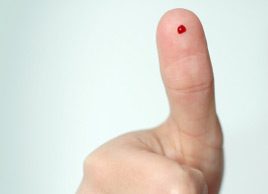How blood glucose meters work
Confused or apprehensive about testing your blood glucose using a meter? Find out how meters work and how diabetics can keep track of their blood sugar

Source: Web exclusive: May 2011
Using a blood glucose meter
If you have diabetes, a blood glucose meter could well be your new best friend, and critical to successfully managing your disease. “A glucose meter is a tool to help know where your blood sugar is at, and what affects it,” says Karen McDermaid, a diabetes educator in Moosomin, Sask.
There are lots of different models of meters’also called blood glucose monitors or glucometers’but they all work the same way: They detect the level of sugar in your blood, and give you the results almost instantly.
It all comes down to chemistry
Wondering how a glucose meter works? Remember high-school science class? First, you use a lancet to pierce your skin and apply a drop of blood to the meter’s test strip. Next, a series of chemical reactions takes place between the sugar in your blood and substances on the test strip, creating ferrocyanide. An electrical current flows from the ferrocyanide to the glucose meter, which uses the strength of this current to measure the amount of glucose in your blood. The meter converts it to the digital number that you record in your logbook.
How not to slip up
It’s possible to get an inaccurate reading if you don’t use your meter properly. But there are steps you can take to reduce that risk. Start by washing your hands and the test area of your skin with soap and water. Dirt and residue on your skin can skew the results. Pay attention to your test strips. If they’ve been exposed to extreme temperatures or they’re out of date, they may not be up to the job. If your meter requires the code number from your test strip container, make sure you’ve entered this properly. And be sure to test a big enough drop of blood’but don’t apply more blood after you’ve already done it once.
Do read the instructions for your particular model, and ask for training from your healthcare professional. "There are lots of differences in the meters," says McDermaid. "It’s important that you understand how to use your meter." You can double-check that your meter is working the way it’s supposed to by using a special control liquid instead of blood, taking a meter reading at the same time as your next lab test, and changing batteries when they’re low.
They’ve come a long way, baby
Blood glucose meters have evolved over the years, and many of the features on today’s devices make them a whole lot more trouble-free. Test results are faster and displays are easier to read. The test strips now work by drawing your blood up from the end of the strip, which means you no longer have to try to place your blood on a specific area of the strip. Some meters no longer require a code from each new container of test strips. Others have reminder alarms, or even a talking function for people with vision disabilities. With some glucose meters you can use test sites on your arm or thigh, where piercing your skin is less painful than on your fingertip.
Modern technology also means smarter meters. Most will store hundreds of readings and calculate trends over a given period of time. With many models, you can enter additional information about what you ate and when you exercised. The information stored in the meter can be transferred to your computer, where it can be graphed and analyzed. In some cases you can even upload the readings to a secure website and share them with your healthcare provider.
If many of today’s meters are smart, others are downright intellectuals. An engineering graduate from the University of California Berkeley with type 1 diabetes has been working on the ultimate know-it-all glucose monitoring system. His meter will automatically send readings to a smartphone, which helps the user enter information about diet and exercise. It then recommends an insulin dosage and saves all the information in an online database.
"We have younger people being diagnosed with type 2 diabetes, unfortunately," says McDermaid. "The technology end of it is really important to them."
Take your pick
How do you know what type of meter is right for you? Best to talk with your pharmacist or diabetes educator. You may want something small and portable, or something that’s easier to use when finger dexterity is an issue. You may benefit from the latest technology, or you might not care if you can connect your cool device to a computer. Choose a model that fits you and your lifestyle. You’ll be well on your way to tracking your health through regular blood glucose readings.
Need help and support managing your diabetes? Like our Facebook page for regular updates, tips and recipes.




